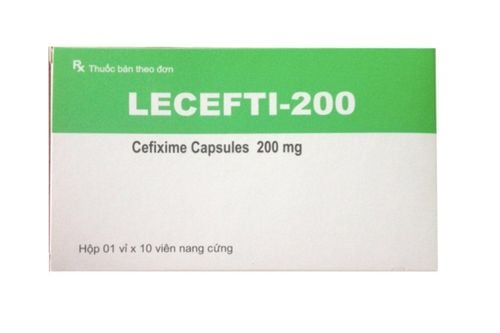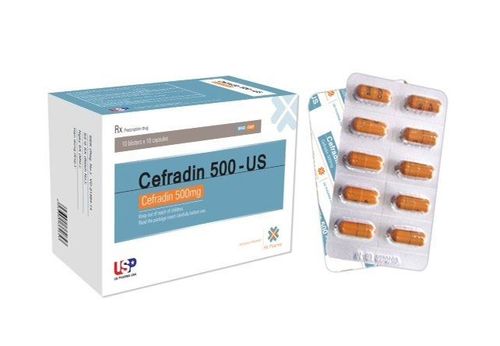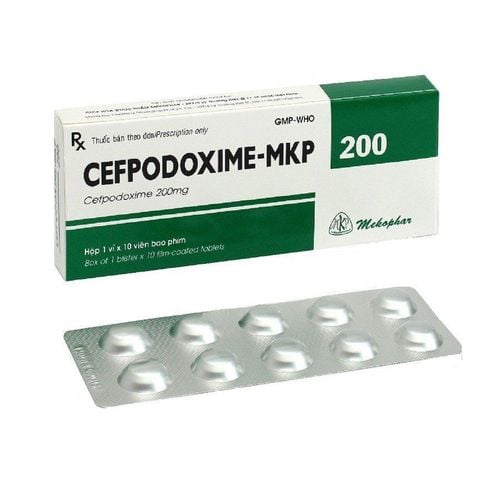This is an automatically translated article.
Chlorfast is a vitamin and mineral form that is highly effective in cases of bacterial infections. However, many people still do not fully understand the ingredients, uses, doses and precautions when using Clorfast.
1. What is Clorfast?
What is Chlorfast drug? Clorfast is a semi-synthetic antibiotic, in the cephalosporin group, in powder form mixed with oral solution, manufactured by the Medical Biomedical & Pharmaceutical Enterprise (MEBIPHAR) - Ho Chi Minh City. The drug is commonly used in cases of soft tissue infections, urinary tract infections, upper respiratory tract infections...
Name of the drug: Clorfast. Classification: Minerals and vitamins. Group of drugs: Belongs to the group of anti-infective, anti-viral, anti-parasitic, anti-fungal drugs. Ingredients: Cefaclor. Dosage form: Powder drug mixed with oral solution. Packing: Packed in boxes of 10 packs of 3g powder mixed with oral solution 125mg/pack. Registration number: VD-1631-06. Manufacturer: Pharmaceutical & Biomedical Enterprise (MEBIPHAR) - Ho Chi Minh City.
2. Uses of the drug Chlorfast
Based on in vitro tests it has been shown that cephalosporins are effective bactericidal, based on inhibition of cell wall synthesis. On the other hand, these tests have also demonstrated the susceptibility of the vast majority of bacterial strains to cefaclor, such as aerobic, gram-positive, penicillinase-producing, coagulase-positive, aerobic, gram-negative bacteria. , Citrobacter diversus, Streptococcus pneumoniae, Streptococcus pyogenes...
That's why Clorfast is indicated for use in cases such as:
Infections in the upper and lower respiratory tract with mild to moderate severity due to susceptible bacteria such as: acute sinusitis, otitis media, recurrent tonsillitis, pharyngitis, pneumonia, acute bronchitis with superinfection, exacerbation of chronic bronchitis... urinary tract uncomplicated by susceptible strains of bacteria (including cystitis, pyelonephritis). Skin and soft tissue infections caused by methicillin-susceptible strains of Staphylococcus aureus or susceptible Streptococcus pyogenes.
3. Dosage and how to use Clorfast
3.1. Dosage of Clorfast is indicated in separate doses for each different subject. Specifically:
Adults: Use with the usual dose of 250mg every 8 hours, taking a maximum dose of 4g/day. For diseases such as bronchitis, tonsillitis, pharyngitis, lower urinary tract infections, skin and soft tissue infections, take 250 - 500mg x 2 times/day, or with a dose of 250mg x 3 times/day. For more serious infections, use 500mg x 3 times/day. Children: Children over 1 month old use with the usual dose of 20-40mg/kg/day every 8 hours, the maximum dose is 1g/day. For children with otitis media, use 40mg/kg/day, divided into 2-3 oral doses. For children under 1 month of age, the dosage is currently undetermined. For patients with renal failure: The drug can be used for patients with renal failure. In severe renal failure, the dosage should be adjusted for adults as follows: Creatinine clearance 10 - 50ml/min, take 50% of the usual dose. , creatinine clearance < 10 ml/min, use 25% of the usual dose. Patients requiring regular hemodialysis: Use with an initial dose of 250 mg - 1 g before hemodialysis, while maintaining the therapeutic dose at 250 - 500 mg every 6 - 8 hours between dialysis sessions. Cup. Elderly: Use the same dosage as adults. 3.2. How to use The drug is prepared in the form of a powder mixed with oral solution, patients can take orally. Just peel off the pack, put the powder in 1/2 cup of filtered water, stir well and drink. Cefaclor is best absorbed when the patient is in a fasted state. Studies have shown that the total amount of drug is absorbed equally whether in the fasted or full state. However, when taken with food, the peak concentration only reached 50-70% compared to the peak concentration when the patient fasted, and reached about 45-60 minutes later.
4. Notes when using Clorfast
4.1. Contraindications Contraindicated to use the drug in patients who are sensitive to cephalosporin antibiotics or any of the active ingredients in the drug. Do not use for infants under 1 month of age. Normally, patients who are allergic or sensitive to any of the ingredients in the drug should absolutely not use it. Other cases are clearly specified in the instructions for use or prescription, doctor's prescription. Contraindications to the drug Clorfast should be understood as an absolute contraindication, not for any reason that is flexible to use the drug.
4.2. It is estimated that about 4% of patients using the drug experience unwanted side effects, of which skin rash and diarrhea are the most common.
Common: ADR > 1/100, eosinophilia, diarrhea, measles-like rash. Uncommon: 1/1000 < ADR < 1/100, nausea, vomiting, pruritus, urticaria, positive direct coombs test, leukopenia, lymphocytosis, neutropenia, pruritus in the genitals, candidiasis, vaginitis. Rare: ADR < 1/1000, serum sickness-like symptoms (usually occurring in pediatric patients under 6 years of age), anaphylaxis, fever, toxic epidermal necrolysis (Lyell's syndrome), Stevens- Johnson, generalized pustular rash, pseudomembranous colitis, thrombocytopenia, hemolytic anemia, hepatitis, cholestatic jaundice, elevated liver enzymes (ASAT, ALAT, alkaline phosphatase), arthralgia, mild elevation of urea blood or serum creatinine or, when urinalysis is abnormal, reversible interstitial nephritis. Rare in the central nervous system: Headache, increased agitation, production of restlessness, confusion, insomnia, dizziness, hallucinations, somnolence, hypertonia, occurrence of seizures (with high doses) In case of undesirable effects, patients should stop using cefaclor, especially when severe diarrhea. Allergic and hypersensitivity symptoms may persist for several months. In severe cases, supportive treatment should be instituted (using adrenaline, oxygen, maintaining ventilation, intravenous corticosteroids).
Usually, unwanted side effects go away after stopping the medication. If you experience rare strange symptoms that are not listed in the instructions for use, you should immediately notify your doctor or medical staff if you suspect any side effects of the drug.
4.3. Caution: Cefaclor, when used for a long time, can cause pseudomembranous colitis. Therefore, special care should be taken in patients with renal failure. Use caution when using the drug for people with diseases related to the gastrointestinal tract, especially colitis, women who are pregnant and breastfeeding. Cefaclor should be used with caution in patients with a history of hypersensitivity to penicillins, in patients with severe renal impairment. Patients should be monitored for renal function when treated with cefaclor in combination with antibiotics with potential nephrotoxicity (such as aminoglycoside antibiotics) or with ethacrynic acid, the diuretic furosemide. Care should be taken in patients with phenylketonuria, because the composition of the drug contains aspartame. A positive Coombs test is required during treatment with cefaclor. Above is important information about the composition, uses, usage and notes when using Clorfast that patients need to know. However, the information that the article provides is for reference only, to ensure effectiveness and safety, you should consult and treat as prescribed by a specialist.
Follow Vinmec International General Hospital website to get more health, nutrition and beauty information to protect the health of yourself and your loved ones in your family.
Please dial HOTLINE for more information or register for an appointment HERE. Download MyVinmec app to make appointments faster and to manage your bookings easily.













